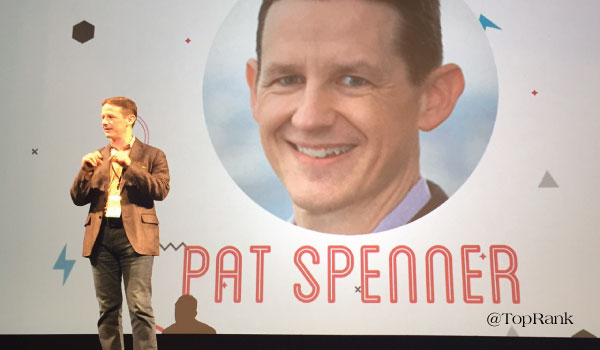
B2B marketers around the globe are all experiencing the same pain. That consistent pain is how to reach, engage, qualify and convert audiences into paying customers.
We’ve all become acutely aware that more content isn’t always better. But now, we’re faced with an even harsher reality about B2B marketing which is that we somehow have to find a way to not only reach the right decision makers, but also figure out how to get them all on the same page.
Pat Spenner of CEB provided some amazing insights at the Uberflip Experience conference into the current state of B2B marketing, as well as ways to approach our marketing in a more data driven way.
The Unhappy Reality of B2B Marketing
When you look overall at the conversion rates of marketing qualified leads (MQLs) at mid to large sized B2B organizations, the reality is that the median conversion rate is only 3%. Ouch!
What that means is that roughly 97% of MQLs don’t ultimately convert. What a bummer right?
One of the ways that marketers have begun counter-acting this reality is by investing in technology and process that allows for more content personalization. But what is the impact of personalized content?
Personalization Conventional Wisdom
Part of the work that CEB does is front-end research that consists of talking to heads of marketing to see exactly how they would define personalization of content.
The standard approach to personalization is as follows:
- Identify key customer decision makers and stakeholders
- Build personas that capture their demographic profile, goals, pain points, fears, etc.
- Use the developed personas to guide more relevant content creation and deliver.
One of the things that CEB also asks marketers is how they believe this chain of logic leads to business value. Typically it looks something like the following:
- Persona-Informed (personalized) Content –> Higher Engagement
- Higher Customer Engagement –> Better Lead Quality
- Better Lead Quality –> Higher Conversion Rates & Higher Quality Leads
Understanding the Implications of Multiple Stakeholders
Another important factor in content personalization is understanding the number of, and different types of B2B stakeholders involved in the purchasing decision.
CEB’s research has found that when you add any additional stakeholders over 5, your likelihood of selling drops to 30%. The bad news? The average size of a B2B buying group is currently at 6.8 stakeholders.
So, if you’re wondering why a high number of your MQLs ultimate end up in no decision, you’re not alone.
How to Encourage Collaborative Consensus with Stakeholders
It’s no mystery that buyers typically make it over halfway through the buying cycle before they’re ready to speak with someone. However, CEB found that when a buyer is roughly 37% of the way through the buying cycle is when they hit peak conflict.
If you’re going to be successful, Pat encourages not to just focus on the “corner office” stakeholder, or even every stakeholder individually. What’s important is to find a way to lower that conflict and help the stakeholders come to a mutual consensus.
What this tells us is that personalization alone (by job title or function) is not enough to encourage consensus.
7 Stakeholder Types
In his presentation, Pat uncovered seven key stakeholder types including:
- The Go-Getter
- The Skeptic
- The Friend
- The Teacher
- The Guide
- The Climber
- The Blocker
It’s important for marketers to neutralize the blocker by focusing on those that “make stuff happen”. These are stakeholders (known as Mobilizers) that will advocate for great ideas that will reframe the way that they think about their business. These people are hungry for new ideas and will implement pressure tests to see how things work before making a move.
Talkers on the other had, may be high engagers with your content and your sales team, but their skillset and ability to drive change is very limited.
The average distribution of these three types as senior decision makers is as follows:
- 38% Blockers
- 36% Mobilizers
- 26% Talkers
Pat suggests cutting back on the energy that is put into Blockers and Talkers and instead focus on empowering the mobilizers.
3 Steps Towards Better B2B Marketing Personalization
Marketers can begin breaking down the roadblocks described in this post by considering the following steps:
#1 – Invest in Interpersonal Personas: Instead of just segmenting personas by job type or function, instead focus on building out profiles that showcase an understanding of who your target (Mobilizers) are and what makes them function.
#2 – Plan Content & Equip Mobilizers: Make sure to build your content playbook in a way that uncovers how your audience profile, insight into how they talk, what objectives you might receive and what messaging will help align stakeholders to make a decision. This approach is what will help get your collective yes and help drive higher quality business and leads
#3 – Create Dog Whistle Content: When developing and executing your content plan, really focus on your Mobilizers and finding a way to create more Commercial Insight focused content. This type of content is a subset of thought leadership and provides insight about a customers business that reframes the way they think about their own company and then leads them to the logical conclusion that your offering is a fit.
How have you approached content personalization in a way that has to account for multiple stakeholders? What was the result?


